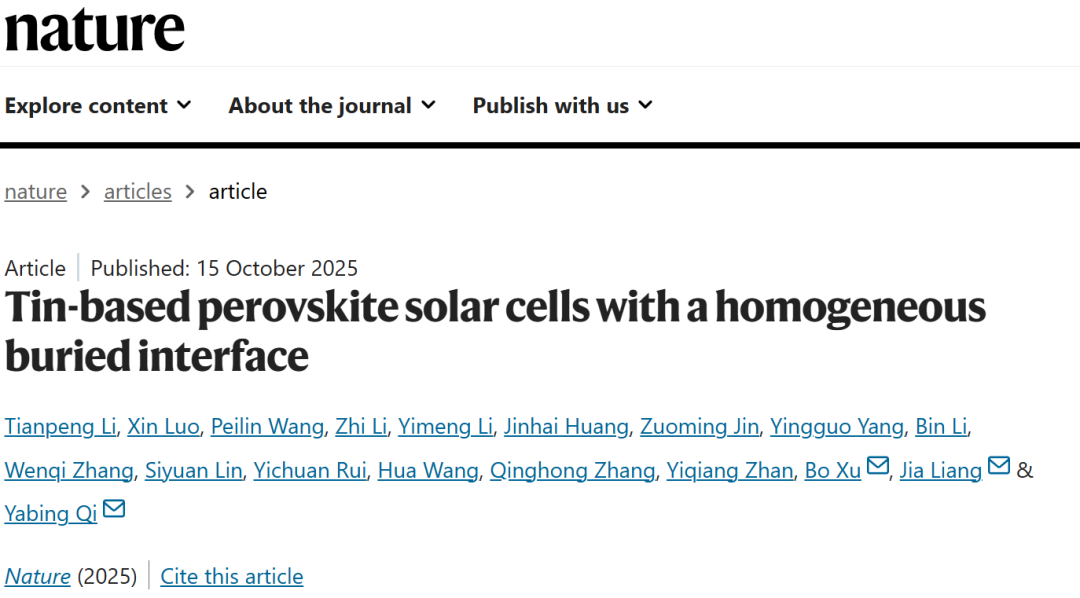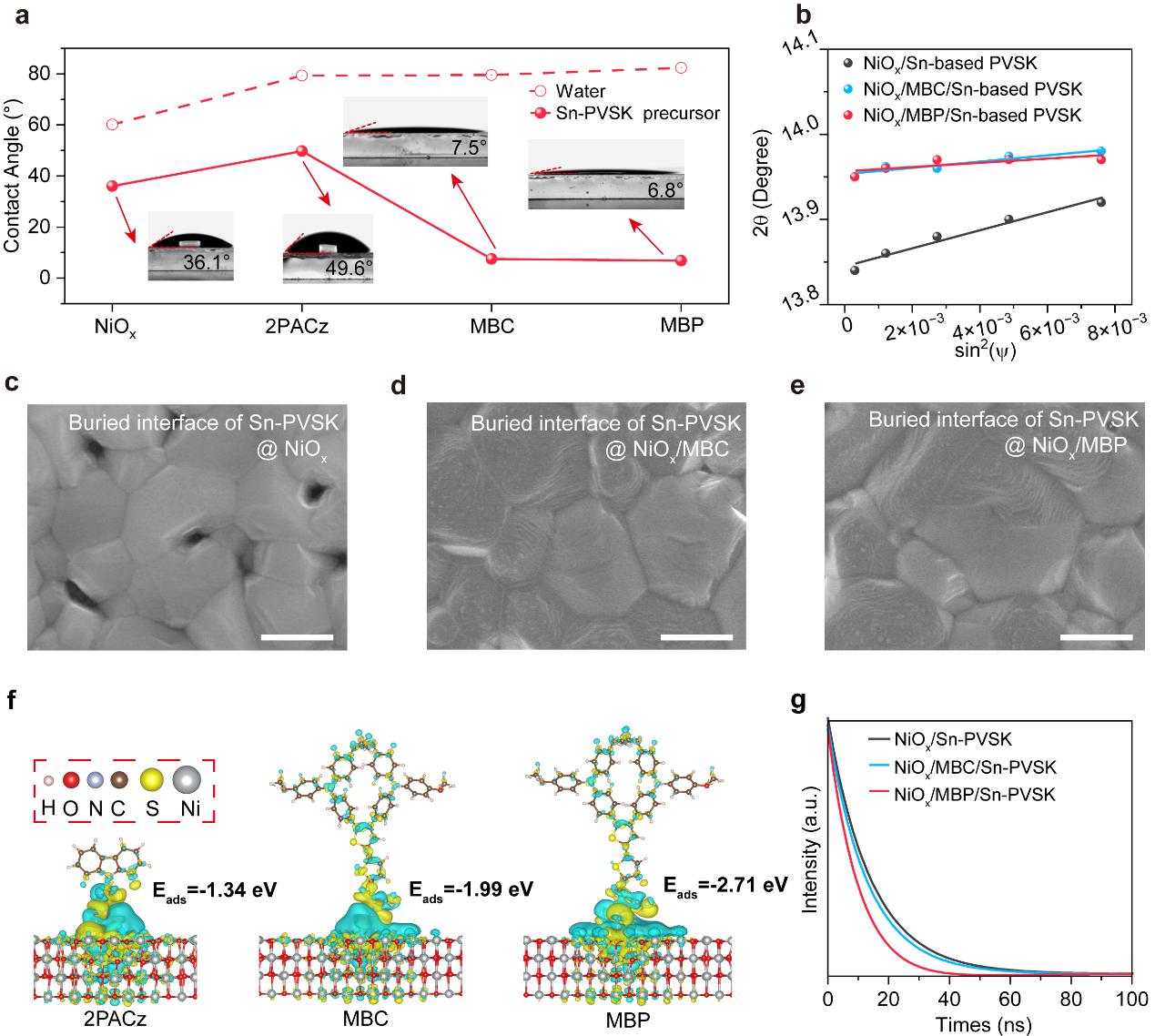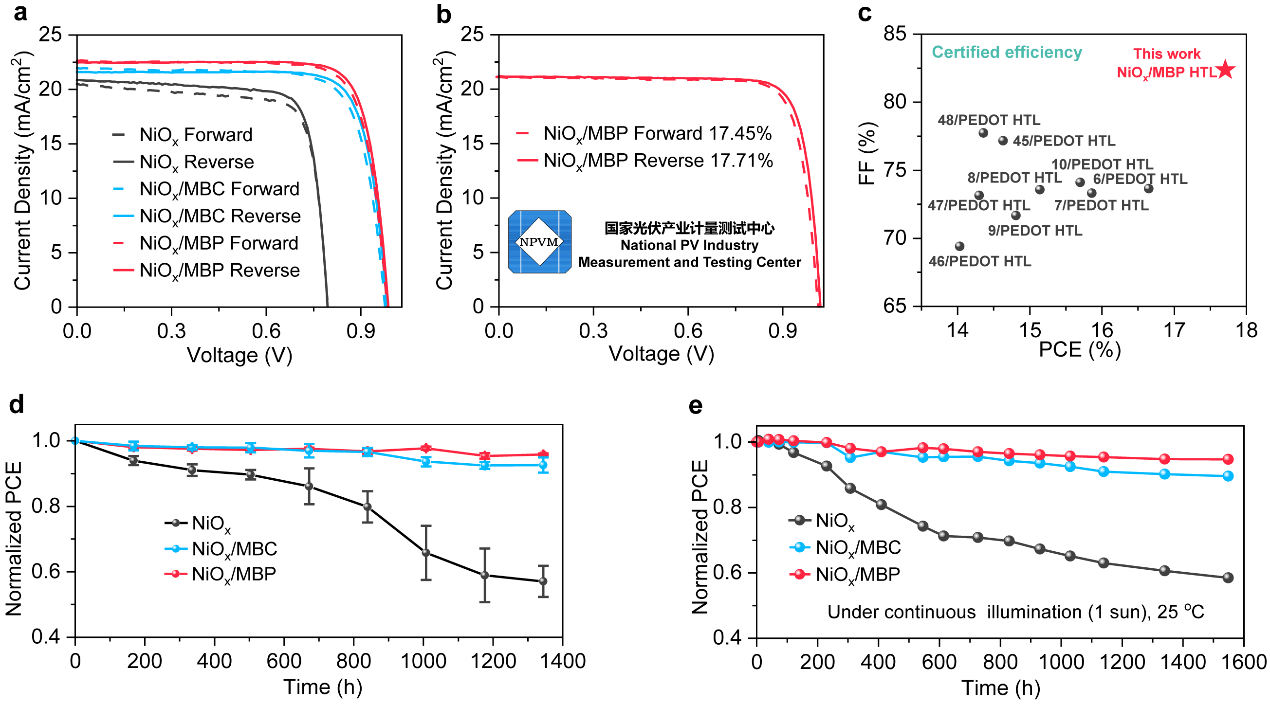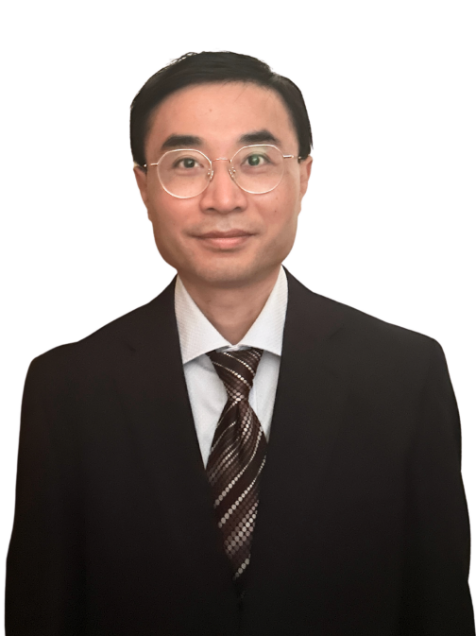GIFT Professor Yabing Qi Publishes in Nature: Farewell to Lead Pollution! Perovskite Solar Cells Welcome a "Green Star"!
High-performance perovskite solar cells have faced environmental controversy due to their reliance on lead for a long time.
On October 15, 2025, a collaborative paper by Professor Yabing Qi from Global Institute of Future Technology, SJTU, Professor Jia Liang from Fudan University, and Professor Bo Xu from Nanjing University of Science and Technology was published in Nature entitled "Tin-based perovskite solar cells with a homogeneous buried interface". This research successfully boosted the power conversion efficiency of tin-based perovskite solar cells to 17.89% (with a third-party certified value of 17.71%), setting a new world record. This breakthrough marks a critical step towards the commercial application of environment-friendly tin-based perovskite solar cell technology.

Figure 1 - Article page on Nature website
Perovskite solar cells have emerged as a promising new generation of photovoltaic technology due to their advantages of high efficiency, low cost, and ease of processing. However, the core materials contain lead, leading to potential environmental and health risks. It remains an urgent challenge for scientific communities at home and abroad to break free from the constraints of lead while maintaining high performance of perovskite solar cells, thus achieving green and environmentally friendly photovoltaic power generation.
Tin-based perovskites are considered the most promising lead-free alternative system due to their ideal bandgap, high carrier mobility, and good environmental compatibility. In inverted tin-based perovskite solar cells, device performance highly depends on the quality of the hole transport layer. An ideal hole transport layer not only requires efficient hole extraction and interface defect passivation capabilities, but should also precisely regulate the nucleation kinetics, phase distribution, stress distribution, and microstructure of the perovskite film. Currently, the polymer PEDOT:PSS is often applied to high-performance inverted tin-based perovskite solar cells as the hole transport layer material. However, the inherent hygroscopicity, acidity, and sensitivity to UV light and moisture of this polymer accelerate the oxidation and degradation of tin-based perovskite materials, significantly limiting device efficiency and stability.
Facing this challenge, the researchers proposed a novel "bilayer hole transport layer" structure. This structure uses highly-stable nickel oxide as the bottom substrate, upon which a self-assembled monolayer (SAM) is constructed, forming a homogeneous and functionally synergistic composite layer. This composite layer acts like a growth template tailor-made for the tin-based perovskite. On one hand, it significantly improves the extensibility of the tin-based perovskite solution on the surface, guiding the formation of high-quality, low-defect tin-based perovskite films. On the other hand, it possesses excellent hole extraction and interface passivation capabilities, allowing more efficient transport of photogenerated current.

Figure 2 - Bilayer hole transport layer inducing high-quality tin-based perovskite film
This innovative design yielded exciting results. The tin-based perovskite solar cells fabricated by the researchers achieved a world-record power conversion efficiency certified by an authoritative third party. Even more notably, the stability of the cells leaped forward significantly by getting rid of the unstable PEDOT:PSS material. Experiments showed that the performance of the encapsulated devices remained almost unchanged after continuous operation for several months, solving the most challenging problem of instability in the tin-based perovskite solar cell field.
More encouragingly, this technological breakthrough is not limited to the laboratory level. The researchers simultaneously conducted research on extensive solar cell fabrication. By optimizing solution processes and film deposition methods, they successfully prepared high-quality tin-based perovskite films several square centimeters in size, achieving a record-level efficiency on large-area devices. This result demonstrates the excellent scalability and engineering compatibility of this technology, laying a solid foundation for future industrial applications.

Figure 3 - Photoelectric conversion performance
Fudan University PhD candidate Tianpeng Li is the first author of the paper. Professor Yabing Qi from Global Institute of Future Technology, SJTU, Professor Jia Liang from Fudan University, and Professor Bo Xu from Nanjing University of Science and Technology are the co-corresponding authors. Other collaborating institutions include Tongji University and Donghua University. This research received support from Shanghai Jiao Tong University, Fudan University, Nanjing University of Science and Technology, and the National Natural Science Foundation of China.
Paper Title:
Li, T., Luo, X., Wang, P. et al. Tin-based perovskite solar cells with a homogeneous buried interface. Nature (2025).
Paper Link: https://www.nature.com/articles/s41586-025-09724-2
Professor Profile

Yabing Qi
Yabing Qi is a Distinguished Professor at Global Institute of Future Technology, SJTU, and Foreign Fellow of the Engineering Academy of Japan. Prof. Qi obtained his B.Sc., M.Phil., and his Ph.D. degrees from Nanjing University, Hong Kong University of Science and Technology, and University of California Berkeley. From 2008 to 2011, he conducted postdoctoral research at Princeton University on the application of surface and interface science in organic semiconductors. From 2011 to 2024, he served as a faculty member at the Okinawa Institute of Science and Technology Graduate University (OIST) in Japan, where he had an early promotion to tenured Full Professor, leading the Energy Materials and Surface Sciences Unit as the Unit head. In 2024, Prof. Qi joined GIFT as a full-time Distinguished Professor.
Over the past two decades, Prof. Qi has made outstanding contributions to surface science and energy materials. In 2022, he received the Kao Science Award from the Kao Foundation for Arts and Sciences in Japan. In 2023, he received the JSPS Prize. In 2024, he was elected as a Foreign Fellow of the Engineering Academy of Japan.
As a distinguished scholar in the fields of surface sciences and energy materials, Prof. Qi has published over 200 SCI-indexed papers in internationally renowned academic journals. He has an H-index of 85 and total citations exceeding 20,000. More than 20 of his papers are ESI Highly Cited Papers. Since 2021, he has been consecutively selected as a Clarivate "Highly Cited Researcher". He is also a Fellow of the Materials Research Society (MRS), a Fellow of the American Vacuum Society (AVS), and a Fellow of the Royal Society of Chemistry (FRSC).
Prof. Qi's research spans multiple disciplines including materials science, physics, chemistry, and electrical engineering. He plans to establish an internationally competitive multidisciplinary research center at SJTU based on surface science and advanced materials, applying fundamental surface science research to the development of energy and functional materials and devices, such as solar cells, lithium-ion batteries, organic electronic devices, light emitting materials, providing crucial technical support for the future development of energy technologies.




